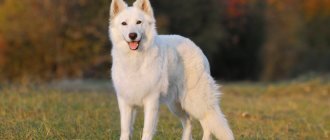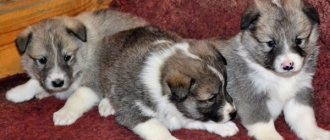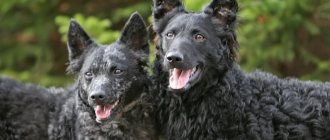The White Swiss Shepherd (American-Canadian White Shepherd) is an amazingly beautiful breed of dog that is similar in appearance and character to the German Shepherd. The only thing that distinguishes them is their color. The White Shepherd is not only graceful and beautiful, but also an excellent companion, as it has a friendly character and developed intelligence.
Description of the White Swiss Shepherd breed
Popularity 164th place among 263 dog breeds
Lifespan:
13-15 years old
Breed group:
Service
Height:
males: 58-66 cm, females: 53-61 cm
Country of origin:
Switzerland
Average price:
30-40 thousand rubles
Weight:
males: 30-40 kg, females: 25-35 kg
Latest articles Cat health
Rabies vaccination for cats: choice of vaccine, necessity, schedule 01/22/2022 4 0 0
Selection and adaptation
TOP 20 best cat breeds for families with children 01/22/2022 25 0 0
Advantages and disadvantages
- Pros:
- high intelligence and curiosity;
- increased endurance, energy;
- good-natured attitude towards children, as well as other pets;
- good working qualities;
- excellent susceptibility to training.
- Minuses:
- the need for frequent active walks in the fresh air;
- severe shedding twice a year;
- high cost of puppies;
- low popularity in Russia.
Psychological picture
American-Canadian dogs have developed intelligence and are easy to train. The character is flexible. They are distinguished by their friendliness, cheerfulness, and patience.
The Swiss have a good memory. An intelligent dog subtly senses the mood of people, is easy to train, and can participate in all types of competitions.
Protective qualities are genetically inherent, so over time the pet begins to control the safety of family members and other pets. However, BShO are not defenders, to the same extent as the Germans. Over the years of selection, their character has softened. Therefore, they lose to the Germans in defense competitions.
Representatives of the breed have a wide vocal range and love to express their mood out loud. This way they also communicate with their family.
For sociable dogs, an important factor of comfort is communication with the owner.
Key facts
The magnificent appearance of the White Swiss Shepherd has captivated many dog breeders around the world. Not only the beautiful exterior, but also the affectionate disposition, good nature, endurance, strength, and irrepressible energy have become the reason for the popularity of this breed.
The characteristics of the White Swiss Shepherd breed say that its name is associated with the country of origin, but there is another name related to the animal’s habitat - the American-Canadian White Shepherd. In canine textbooks you can find the letters BShO, denoting the abbreviated name of the breed.
Representatives of the Swiss breed have high intelligence. This greatly facilitates their socialization and training. Her love for movement and physical activity makes her an excellent companion for those who follow a healthy lifestyle.
In general, their loyalty and affection for their owners is limitless. It is important for Shepherd dogs to feel love and attention from a person, otherwise their life will be extremely unhappy.
The pet is similar in appearance to the German Shepherd, but, unlike it, the Swiss is less aggressive and not so excitable. She does not take well the familiar attitude towards herself from a stranger, but she will show aggression only if there is a threat to herself or her owner.
The description of the White Swiss Shepherd breed says that it is most convenient for dogs to live in a private home, where it will have the opportunity to splash out energy. But she adapts well to life within the city.
The White Swiss Shepherd is a fairly large dog. Thus, females weigh on average 25-35 kg, and the weight of males reaches 30-40 kg. The height of a white Swiss shepherd female is 53-61 cm, the height of males at the withers is 58-66 cm. The life expectancy of a white Swiss shepherd is 13-15 years, but long-livers are often found.
Character and appearance
These dogs perfectly adapt to being in any climate and can live in an apartment or enclosure. Behavioral features of the white shepherd include:
- absence of causeless aggression;
- protection of the owner in the event of danger;
- obedience;
- love for children;
- inability to bear loneliness.
These representatives of the breed are muscular and well built. The body has smooth outlines, a saber-shaped tail, and brownish eyes. The nose is dark. Coat color is white.
History of the origin of the White Swiss Shepherd
For a long time there was a wonderful legend that this pet was the fruit of love between a shepherd dog and a white polar wolf. In fact, one cannot completely deny the participation of a white-haired animal from the Arctic in the emergence of the breed. But breeding scientists speak out in favor of deliberate mixing of the blood of fair-haired representatives of the German Shepherd.
Already in the 19th century there were references to herding dogs of an unusual white color. And in 1882, a white German shepherd named Greif appeared at the Hanover Exhibition. His descendants became the first to be officially registered in the pedigree book of the Swiss breed in 1899.
Over time, the working qualities of the shepherd faded into the background, but endurance, excellent trainability, strength and extraordinary intelligence turned the shepherd into a very popular breed in Western Europe and the USA. Moreover, the improvement in performance qualities did not affect the appearance of the pet.
In the 1930s, white shepherd dogs were banned in Nazi Germany because they were considered dogs of the wrong genotype. This attitude towards white-haired individuals persisted until the 60s of the last century.
At the same time, in the United States of America and Canada, such pets were becoming increasingly widespread. They were among the favorites of rich people. For example, the Rockefellers preferred these shepherds to any others.
The appearance of the name “American-Canadian Shepherd” is associated with breeding work carried out to improve external and performance characteristics in these countries. It was in this form that they began to return to Europe in the second half of the 20th century.
The breed first settled firmly in Switzerland, where in 1966 it was officially re-registered in the Swiss studbook. The popularity of white pets has grown every year. Only on the territory of modern Russia did the Swiss-American-Canadian animal not receive the widespread distribution it deserves.
How to choose a puppy
When choosing a puppy to guard your home, you should pay attention not only to the pedigree, but also to the image of the breeder. If this is a specialized nursery, then you can be sure that the parents for the puppies are selected carefully. To do this, you should contact the following nurseries: Carnelix, Hearty Gem, Belle Etoile. The characteristics of the breed indicate that the Swiss Shepherd should have a pure white color. Therefore, a puppy for 1 month should be white without tan.
Pet price from 10,000 rubles. You also need to make sure that the dog is not deaf. To do this, you should ask the breeder for a BEAR test and an x-ray of the spine. You need to pay attention to how the puppy behaves. If the baby is curious, friendly and balanced, then everything is fine with him.
Dog names
Choosing a nickname for a purchased puppy is an exciting task. I want to choose a name that is beautiful, interesting and unique.
- Suitable nicknames for a boy are Wenzel, Marcus, Besh, Dark, Eugene, Aivar, Celt, Felix.
- The girl can be called Rada, Alma, Corey, Bayra, Besta, Deisi, etc.
Similar dog breeds
German Shepherd
Sheltie
Beauceron (French Shepherd)
Appearance of a White Swiss Shepherd
General impression
In appearance and in the photo, the White Swiss Shepherd is very similar to the German Shepherd, only with a denser build. There are long-haired individuals, as well as representatives with medium-length fur. The first animals are more common in Germany, France, Austria, their counterparts live in North America and the Netherlands.
Head
Proportional to the body, the shepherd's head has the shape of a wedge, which is clearly visible from above or from behind. The outline of the skull is straight, with a smooth transition from the line of the forehead to the muzzle. The long muzzle tapers slightly towards the nose. According to standards, a medium-sized nose should be black or simply dark in color.
Massive jaws with perpendicular teeth have a scissor bite. Dry lips are colored black and are also tightly connected to each other.
The tips of the Shepherd's ears are slightly rounded. In a calm state, they are located straight, with a slight bend forward.
The eyes are small, almond-shaped and come in shades from brown to dark brown with an obligatory black rim.
Neck
The elongated neck does not have a pronounced dewlap. Despite the powerful muscles, it is gracefully arched in the transition from the head to the withers.
Torso
The long, prominent body of the animal looks very graceful. The croup is somewhat inclined towards the base of the tail, the chest is dry, powerful, of medium width, and quite deep. The belly forms a straight line. The withers are well defined. The back is straight and very strong.
Forelegs
The front paws of the Swiss are dry and strong. If you look at the animal directly, the limbs seem to be quite widely spaced from each other. The shoulders and forearms are long, with well-developed muscle mass. Large pasterns are located slightly obliquely.
Hind limbs
Straight, parallel hind legs look powerful. Thighs with prominent muscles are of medium length. The shins have strong bones. The hocks are dry, medium-sized, with tightly clenched toes. Pads and claws should be black.
Tail
The tail of the Swiss breed is saber-shaped and covered with thick hair. It is located quite high, reaching almost to the hock joint. When excited, the tail is raised, but not above the top line. When at rest, it hangs towards the ground.
Movement
The shepherd moves measuredly, rearranging its limbs one by one. The movements look very powerful. When switching to a trot, the gait changes to a creeping, almost creeping one.
Wool
Both long-haired individuals and individuals with medium-length hair have thick fur. The structure of the wool is straight and hard to the touch. According to the standards, slight waviness is allowed.
Color
Any color other than white is considered a violation of breed standards. So the colors of the White Swiss Shepherd are limited to one option.
Size
In terms of size, the Swiss Shepherd is a fairly large dog. The height at the withers for males is 58-66 cm, for females – 53-61 cm. The weight of a White Swiss Shepherd for males reaches 30-40 kg, for females – up to 25-35 kg.
Personality of the White Swiss Shepherd
With a balanced character, the Swiss Shepherd is very energetic, inquisitive and good-natured. However, her softness and certain restraint should not be misleading. She has the same service qualities as her more evil relatives: quick reaction, strength, tirelessness. This allows representatives of the breed to be used as watchmen, rescue assistants, bodyguards, and guide dogs.
On the other hand, they love to play ball, swim, and go for long runs. White dogs get along well with all people and other animals living with them in the same house. They simply adore children, will never offend them, and will calmly endure their pranks. At the same time, the pet will manifest a herding instinct, so it will begin to carefully monitor that nothing happens to the human cub.
It is interesting that a shepherd dog will treat a domestic cat or other animal with the same care and patience. Your pet will have a wary attitude towards strangers. However, the dog will not be the first to show aggression, but will distantly observe the behavior of the stranger.
The animal feels the greatest love, as well as devotion, for its owner. There can only be one. The Swiss needs his care, affection, and attention most of all. In addition, she knows how to express her emotions with her voice. So grunts, groans, whimpers or squeals will fully express the emotional state of the pet.
Diseases and life expectancy
The average life expectancy of representatives of this breed is 30 years. Light colored shepherds are prone to the following diseases:
- Dysplasia. When buying an animal, you need to request x-rays from the seller, which confirm the absence of violations.
- Deafness.
- Heart failure.
- Mental abnormalities (overly timid/aggressive).
Education and training
Raising and training a White Swiss Shepherd, according to owners, is a pleasant experience. Smart, with a lively intellect and excellent memory, dogs understand everything the first time and strive to execute commands accurately and immediately. The only thing that is required from the trainer is consistency in performing the exercises.
Usually there is no point in using harsh methods during training because the dog is obedient from birth. However, firmness and also confidence should be heard in the owner’s voice during training. It is important to conduct training from simple to complex, alternate group lessons with individual ones, and be consistent in actions.
By the beginning of the main stage of training, the young animal should:
- follow hygiene rules;
- respond to your nickname;
- be able to go for walks on a leash.
Socialization of a pet occurs at an early age, but this does not mean that the owner should not take part in it. A poorly trained shepherd can become aggressive towards other people or animals.
Looking for a White Swiss Shepherd? Find your pet from 1 offer As a gift
Health and Diseases of the White Swiss Shepherd
Possible diseases
The White Swiss Shepherd, like its German counterpart, has a strong immune system, as a result of which it rarely suffers from various diseases. It was previously believed that light coat color genetically predisposes to numerous severe pathologies. However, with his entire happy life, the dog refutes this erroneous point of view.
There are a number of diseases that occur in Swiss dogs more often than in other animals:
- eosinophilic panostitis, also called growth disease, manifested in lameness of shepherd dogs 5-12 months of age;
- paresis of the pelvic limbs, limiting the dog’s motor activity;
- intussusception or one of the forms of intestinal obstruction;
- congenital heart problems.
Like all active individuals, white shepherds suffer from pelvic dysplasia, dislocations, and bruises. Due to an unbalanced diet or overeating, skin dermatitis, food allergies and obesity are possible.
To maintain your pet's health, you should not forget about routine vaccinations. Vaccinations are given from two months of a puppy’s life, and then according to a schedule. They are vaccinated against distemper, parainfluenza, hepatitis and other infectious diseases that are life-threatening to the four-legged animal.
Reproductive health
Mating of individuals is carried out during the third estrus of the bitch. By this time, she is completely ready for pregnancy, as well as for the birth of strong offspring. This happens by the age of one and a half years.
The sterilization operation is carried out when the female is one year old. This will help to properly rebuild her body and protect her from complications.
Vaccinations
To avoid dangerous viral and infectious diseases, it is necessary to get vaccinated on time:
- First, at 1.5 months, puppies are vaccinated against parvovirus and coronavirus enteritis, and against hepatitis.
- Revaccination after 2 weeks.
- The second - at 2.5 months. Puppies are vaccinated against distemper. Repeatedly – 6-7 months after changing teeth.
- The third - at 8 months from rabies.
Two weeks before vaccination, the puppy should be given anthelmintic drugs. At the time of vaccination, the pet must be healthy.
Features of feeding and diet
The White Swiss Shepherd has a good appetite and is not picky about food. But this does not mean that the owner should not monitor its diversity and balance.
The owner decides what to feed the pet. A dog will eat natural food or industrially produced dry food with equal gratitude. Here it is important to be attentive to the needs of the pet and its age.
So, puppies up to six months should be fed at least four times a day, starting from six months of the baby’s life and then switching to two meals a day. The norm is determined by the bowl. If it remains empty after feeding, then the amount of food is determined correctly. Otherwise, it is better to reduce the feeding rate.
You cannot feed a Swiss Shepherd dog food from the owner's table. There is no need to succumb to picturesque requests frozen in the eyes of your pet. Human food is very harmful as it contains preservatives and dyes that can cause skin dermatitis or food allergies in your four-legged friend. Excess portions lead to overeating, and subsequently to the development of obesity.
With a natural diet, most of the diet consists of meat products: beef, lamb, offal. They can be boiled or given raw. Porridge is also necessary for good digestion of the animal. Oatmeal, buckwheat or rice are best. It is useful to include boneless sea fish, vegetables and some types of pitted fruits in the menu.
It is recommended to give low-fat cottage cheese and fermented milk products to babies from the age of one month. No more than twice a month they are treated to a boiled egg.
We must not forget about vitamin-mineral complexes, which, on the recommendation of a veterinarian, are introduced into food.
When using dry food, you must carefully select the type. The main thing is that it is expensive premium food. They already contain all the necessary beneficial additives. We must not forget about the correct drinking regime for your pet.
Best nicknames
The nickname should suit the shepherd, emphasize its appearance, size, gender and reflect the specifics of the breed. Many dog owners, when choosing names, focus on the color of their pet. This provides an excellent opportunity to choose a suitable nickname for the animal.
Table: popular nicknames for the Swiss Shepherd
| Males | Bitches |
|
|
Animal psychologists say that a dog’s name can influence the formation of character and even the future of a four-legged friend.
Care and maintenance
Caring for a White Swiss Shepherd is no more difficult than caring for other representatives of the herding breed. Despite the thick coat, special attention should be paid to its care only during the molting period. Twice a year, namely in winter and summer, the dog must be combed twice a week.
Short-haired pets are simply combed with a fine-toothed comb, while long-haired pets are encouraged to use a special spray to facilitate the removal of tangles. The clump of hair can be carefully cut out if the comb and spray do not cope. To complete the hairdressing procedure, the hair is smoothed with a brush with natural bristles, and then run through it with damp palms to remove any remaining dead hair.
It is important to keep your pet's mouth clean. At least once a week, your four-legged friend needs to brush his teeth. To do this, use a brush and a special dog toothpaste, which can be purchased at a veterinary clinic. Movements during the procedure should be from the base of the teeth to the edges.
The eyes are wiped every day with a cotton pad soaked in boiled water to avoid possible inflammation. The ears are examined and freed from dirt at least twice a month. The claws are trimmed using a special nail clipper and a file to handle irregularities. Do this once a month.
Despite their light coat, the Swissie should not be bathed more than twice a year. Shampoos have a bad effect on your pet's hair structure. The paws and belly should be washed or wiped with a damp towel after each walk. Washing especially contaminated areas of the coat can be done using dry shampoos designed for this purpose.
Dogs are walked at least three times a day. At the same time, walks should be active, include jogging, games, and elements of training. It would not be a bad idea to walk in places where other dogs are walking with their owners. This will help your white shepherd enjoy the outdoor activities even more. Only this can be considered difficult in the care and maintenance of a white Swiss shepherd; everything else does not require any hassle.
Walk
In order for BShO to remain cheerful and healthy, she needs to be walked. When kept in a country house with a large local area, the issue of walking is resolved by itself. But even in this case, it is necessary to train the pet, loading not only the muscular system, but also the intellect.
When kept in an apartment, many hours of daily walking are required. The dog must move a lot, run over rough terrain, and overcome obstacles.
If you don't provide your pet with enough exercise, it will lose its physical shape and may get sick.
Tips for choosing a puppy
The youth of the breed is the reason for the small popularity of the White Swiss Shepherd in Russia. It is impossible to buy a puppy of this breed at the poultry market or through an advertisement.
Unscrupulous sellers are trying to pass off light-colored babies of half-pedigreed dogs as purebred Swiss representatives. In fact, you can only buy a purebred puppy in special nurseries, where they provide the necessary documents about the pedigree of your future four-legged friend.
A healthy white Swiss Shepherd baby will be active with a shiny, soft coat. The coat should not be yellowish. The puppy's ears and eyes should be clean, without signs of inflammation. According to breed standards, the color of the irises is only brown. The nose is moderately cold and damp.
Ask the seller to show the parents of the future pet. Observe their behavior. They should not be overly fearful or overly aggressive. Ask about hereditary genetic diseases that your baby's relatives may have suffered from.
At the time of purchase, the puppy must have a veterinary passport indicating the date of the first comprehensive vaccination. White Swiss Shepherd puppies must be treated for worms while still in the kennel.
Mating
The female White Swiss Shepherd is physiologically ready for mating by 12 months. However, it is not recommended to knit them before 20 months. For males, the optimal period for the first mating is the age of 24 months.
Bitches can be mated starting from the third heat, 11-14 days after the appearance of discharge. This phase is called estrus. Conception is most likely at this moment.
According to general recommendations, dogs should be vaccinated and healthy.
Mating is carried out in the morning. Dogs cannot be fed, but they must be given a good walk. Mating in the vast majority of cases is carried out “on the territory” of the male dog. The time allowed for introductions is from 5 to 15 minutes. Usually during this time the bitch has time to prepare for mating. If she stops, stands in a characteristic straight stance, and moves her tail to the side, this is a signal that it is necessary to start mating.
If it is not the first time that dogs are involved in mating, the intervention of the owner or instructor is usually not required.
Read a detailed article on the topic: “Everything you need to know about breeding dogs: appropriate age, what to do if it doesn’t work out, rules and tips.”
How much does a White Swiss Shepherd cost?
The price of a white Swiss dog will depend on its pedigree, the popularity of the kennel and the class of the pet. Thus, a pet-class baby, who will simply be a pet, can be purchased for 25-30 thousand rubles.
Future breeding representatives of the white breed, the so-called breed class, will cost from 30,000 to 40,000 rubles. Show-class puppies, which are intended for exhibitions or shows, and therefore meet all breed standards, will cost from 50,000 rubles and more. If you don’t have a pedigree, you can buy a little Swiss for no more than 15,000 rubles.
Do you like the article? 0
Buying a white German Shepherd, puppy prices
When buying a white German Shepherd puppy, you should not go for cheap prices. Should be purchased from trusted nurseries with a reliable reputation or from experienced breeders. Before making the final choice, you need to take a closer look at the entire litter, observe the behavior of the babies and get information about heredity.
The cost of a German depends on his age, the region of purchase, the pedigree of the parents and their title. The average price ranges from 15,000 rubles to 45,000 rubles.











